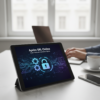After years of listening "It's coming!" Rich Communication Services (RCS) is finally a reality for many consumers. Google's Android phones have it and Samsung users have the ability to use it. Apple hasn't announced plans to adopt RCS, but experts expect the move to be almost inevitable. For companies looking to conduct mobile experiences, RCS adoption is a game changer.
What is RCS?
RCS is a communication protocol used by mobile phone operators that represents the next generation of SMS messages. Until recently, most of what happens in the phone's default messaging app is purely textual (with a healthy dose of emojis). With RCS, your smartphone's native messaging app will support rich messaging features, making its default messaging flow much more like WhatsApp, Messenger or Instagram Message. Many Android users are already experimenting with what RCS is all about. RCS features include:
- [Most importantly!] App-like functionality: Users are no longer limited to simple text-based exchanges. Share a survey or rating that can be filled out in the message flow. Change reservations, book tickets, make a purchase, update privacy settings - again, all without leaving the native phone messaging app
- Larger File Size: Consumers and businesses can send larger files, including GIFs, videos, hi-res photos, PDFs, etc.
- Send a sms! Similar to messaging apps like Messenger and WhatsApp, RCS has no character limits
For marketing and CX leaders, this shift is a huge shift in the mobile engagement landscape. Using RCS, companies can interact in new and interactive ways. Do you want to inform a customer that a package is on its way? Instead of sending a simple “your package is arriving today” message, share a map that shows updates in real time and allows customers to provide specific instructions (eg “Leave it on my porch, please!”).
Five ways RCS will promote how companies reach their customers and drive higher sales
1. Higher conversion rates
RCS offers companies the ability to deliver highly personalized messages in a much more interactive format. And a better experience means higher conversion rates. Let's take a look at some industry scenarios:
Voyage: a hotel chain wants to inform customers about Valentine's Day offers. Using SMS / TXT, the hotel can send a short text-only message plus a hyperlink. Using RCS, the hotel can send photos of its promotion destinations with their prices, develop insights into which promotions are grabbing the attention of specific customers, and use the data to form a clearer 1: 1 shopper journey. Once the client has booked the deal, using RCS the hotel can offer further deals, from upgrades to the rooms to champagne and roses waiting in the room.
Health care: a pharmacy wants to increase loyalty by helping its customers manage prescriptions. Using traditional text messages, the chain reminds the customer that a top-up order is on the way. “Do you want to fill out your prescription for metformin? Text Yes or no . ”Using RCS, the customer can manage all his prescriptions in the sms flow, activate the automatic refills and suspend the others, and notify when they will be present to collect the next refill.
Retail: a home product chain wants to develop deeper relationships with their customers. Using SMS, it sends a notification of an upcoming sale. With RCS, the retail chain sends sales prices for half a dozen products that the customer is most likely to want based on analyzing their purchase history - and gives customers the ability to buy without leaving. text message flow
How big is the performance leap from SMS to RCS? The French insurance company Macif reports that the click-through rates on RCS are double those of SMS and 3 times that of e-mails.
2. Reduce the clutter of the channels
Sinch's research shows that consumers are excited about next-generation mobile messaging and, in particular, find the idea of aggregating ALL messaging into the phone's default inbox “extremely useful”. (See table below.)
Therefore, even as brands are committed to multiplying the number of messaging channels they use to reach customers, consumers suggest they would like less channels.
Consumers want to simplify messaging
Would it be helpful if all mobile chat tools are placed using the phone's default TXT / SMS application?

3. Real-time utility
One of the main advantages of RCS is to allow companies to provide their customers with an updated and real-time utility. Eg:
Changing the booking of a flight without a call center: le Inbound calls to call centers take time for the customer and are expensive for a business. Using RCS, customers can request changes to their itinerary and be able to send a new copy of their ticket or boarding pass directly to their inbox.
Abandoned cart targeting: remind customers of incomplete checkouts by sending pictures of the items they left in their online carts, and even let them complete their purchase from their inbox.
Increase Delivery Completions: let customers know their package is on the way and give them selectable options to drop off in a safe place or schedule a return - all without having to leave their inbox.

These types of interactions are valuable because, by their nature, they are personalized. only suitable for a single individual. As Michael Ricci, Master Principal Solutions Architect at Oracle's CX Center of Excellence, recently shared the Sinch Mobile Consumer Engagement 2020 report:
“Without personalizing the customer experience, most consumers give up. That's the biggest challenge: helping brands understand it's time to bring that data together so they can holistically personalize their touches with consumers. "
4. Bypass disabled notifications
Sinch's research shows that 1 in 4 consumers "often" disable app notifications on their phones (and the ratio rises to 1 in 3 for Gen Z). For brands that rely heavily on their apps to reach customers, this presents a problem: they may be missing time-sensitive information. Native messaging, however, is far less likely to be turned off. According to Sinch's research, half of consumers have zero unread messages in the inbox and the 85% has 10 or fewer unread messages. The lesson? Native messaging achieves its goal at an incredibly fast pace.
5. More in-depth metrics
With the advent of RCS, marketing and customer experience leaders have a much more robust dataset at their disposal. Rather than a simple "read receipt", messages sent via RCS have the same depth of analysis available that could be found using e-mail. For instance:
- Messages sent, delivered and opened
- Click-through rate, including the best performing part of the message
- In-stream engagement and completed actions / transactions
- Call center metrics, including resolution rate and sentiment analysis. "With richer data, companies have the ability to better understand the customer to refine how they reach, engage and convert each individual through more personalized communication.
For businesses, RCS messaging is an effective way to create conversations more engaging with customers and delivering much higher utility value on mobile devices. And according to Sinch's research, consumers are ready and willing to try new uses for mobile messaging.







